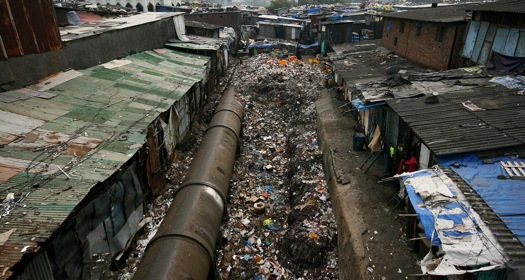
Inadequate sanitation bedevils slums such as Dharavi in Mumbai, India. Photo courtesy San+Co.
India has one of the world’s fastest growing economies and an emergent middle class, but an estimated 37 percent of the country’s 1 billion population still live in poverty and lack basic infrastructure. This disconnect is most evident when looking at popular products and services: there are more cell phones in use in India (about 700 million) than toilets (around 600 million), while 400 million lack access to electricity. Swapnil Chaturvedi, who was born and raised in India before going to the U.S. a decade ago to study mechanical engineering and design management at Northwestern University, wants to change that equation with a social enterprise he founded called San + Co. The idea is to create a closed loop system that provides a sustainable sanitation solution and, at the same time, off-grid electricity to homes. In India, Chaturvedi observes, “People will pay for what they want, like a cell phone, but not for something they need, like a toilet, so our business model is based on making sanitation an aspiration.”
The project, which recently won first prize at KIN Global, the annual conference of Northwestern University’s Kellogg Innovation Network, is based on the idea that India’s urban slum dwellers, who earn between $2 and $5 a day, would be willing to pay an estimated $6 to $7 a month for a system that provides a toilet and electricity for an entire family. The process starts with a specially designed toilet for the home, alleviating the usual ritual of defecating in the street or walking long distances and paying to use a public toilet. People known as scavengers, for whom the caste system allows only menial jobs, will collect the waste containers and receive a uniform, a salary and protective apparel, providing them with steady work and income and expanding the social aspect of the project. Then the waste is taken to a biogas facility for conversion to fertilize to be sold to farmers — a major source of revenue for San+Co — and to biogas to charge batteries that are then returned to the homes to provide electricity.

Different San+Co commode designs incorporate a covered container for transporting waste to a biogas facility.
After an initial pilot program in Raipur and further research, a number of changes and modifications are being made. The toilet was redesigned to accommodate the squatting position, which is common in India, and sitting, for older people. The team also realized that an aggressive educational plan was also needed to teach people about sanitation. Moreover, social recognition is being integrated into the marketing strategy: those who have a San+Co system can display a special decal on their homes saying they are now the proud owners of a toilet and a battery.
With $40,000 in prize money, San+Co wants to resolve several issues before a second pilot begins. One is another toilet redesign – with help from the nonprofit design firm Catapult in San Francisco — to deal with the smell from the waste container, which can be unbearable in the extreme heat common in India. Reliable partners with enough capacity must also be found for the biogas conversion and electricity distribution. If it works, San+Co will be able to provide sanitary facilities, improve health and bring electricity to homes that are either dark or lit by dangerous kerosene. But first, Chaturvedi acknowledges, “we have to make toilets as sexy as cell phones.”
